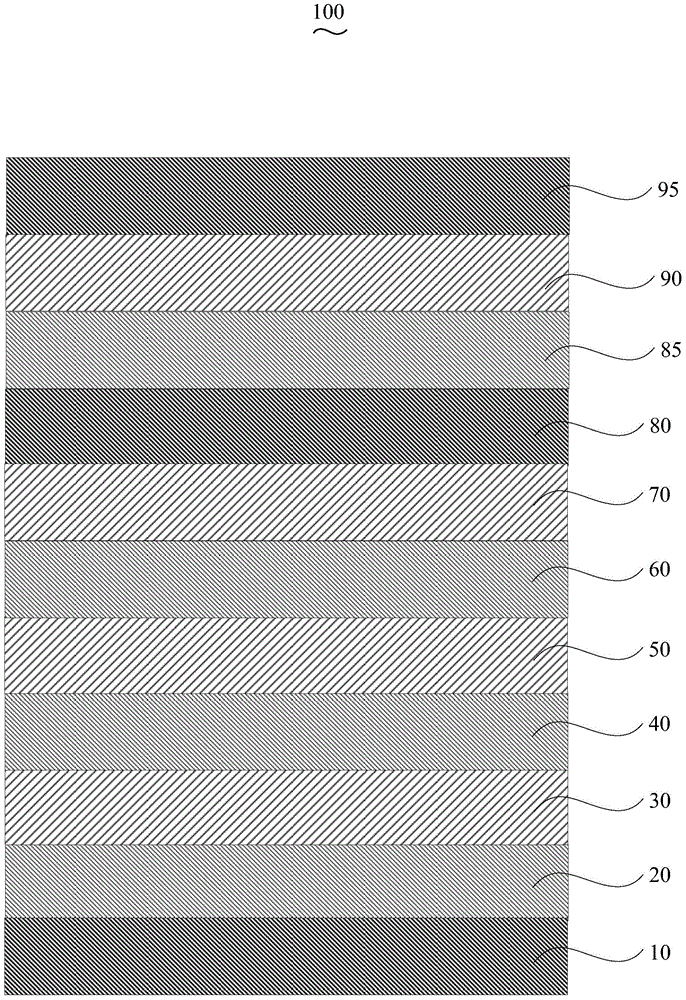Antireflection glass and preparation method thereof
An anti-reflection glass and glass substrate technology, applied in chemical instruments and methods, glass/slag layered products, layered products, etc., can solve the problem of easy scratches, affecting product appearance and customer acceptance, and destroying anti-reflection coating optics. effects, etc.
- Summary
- Abstract
- Description
- Claims
- Application Information
AI Technical Summary
Problems solved by technology
Method used
Image
Examples
preparation example Construction
[0067] The preparation method of above-mentioned anti-reflection glass, comprises the steps:
[0068] S10 , providing an aluminosilicate glass substrate 10 .
[0069]Preferably, the thickness of the aluminosilicate glass substrate 10 is 0.4-0.7 mm.
[0070] Preferably, the refractive index of the aluminosilicate glass substrate 10 is 1.50˜1.52.
[0071] Preferably, the aluminosilicate glass substrate 10 is cleaned and dried first.
[0072] S20, sequentially depositing the first low refractive index layer 20, the first high refractive index layer 30, the second low refractive index layer 40, the second high refractive index layer 50, The third low-refractive-index layer 60, the third high-refractive-index layer 70, the fourth low-refractive-index layer 80, the fourth high-refractive-index layer 85, the fifth low-refractive-index layer 90, and the fifth high-refractive-index layer 95 are obtained. reflective glass.
[0073] The material of the first low refractive index laye...
Embodiment 1
[0106] The structure of the anti-reflection glass in Example 1 is glass substrate / SiO 2 / Nb 2 o 5 / SiO 2 / Nb 2 o 5 / SiO 2 / Nb 2 o 5 / SiO 2 / Nb 2 o 5 / SiO 2 / Si 3 N 4 Wherein, " / " represents a stacked structure, and the values in brackets represent thicknesses, which are the same in the following embodiments.
[0107]The material of the glass substrate in Example 1 is aluminosilicate glass with a thickness of 0.7 mm.
[0108] The anti-reflection glass in Example 1 is measured by using Nippon Denshoku’s SD-6000 to measure its full-band transmittance and reflectance in the visible light range with a wavelength of 380-780nm. The measured average transmittance is ≥ 94.5%. Reflectance ≤ 1%.
[0109] The hardness of the anti-reflection glass was tested using a pencil hardness tester, and the hardness was 7H.
[0110] A certain amount of the anti-reflection glass was taken and soaked for 2 hours in NaOH solution with a concentration of 10wt% and...
Embodiment 2
[0114] The structure of the anti-reflection glass of embodiment 2 is glass substrate / Nb 2 o 5 / SiO 2 / Nb 2 o 5 / SiO 2 / Nb 2 o 5 / SiO 2 / Nb 2 o 5 / SiO 2 / Si 3 N 4
[0115] The material of the glass substrate in Example 1 is aluminosilicate glass with a thickness of 1.1 mm.
[0116] The anti-reflection glass of Example 2 is measured by using Nippon Denshoku’s SD-6000 to measure its full-band transmittance and reflectance in the visible light range with a wavelength of 380-780nm. The measured average transmittance is ≥ 94.5%. Reflectance ≤ 1%.
[0117] A pencil hardness tester was used to test the hardness of the anti-reflection glass anti-reflection film layer, and the hardness was 7H.
[0118] A certain amount of the anti-reflection glass was taken and soaked for 2 hours in NaOH solution with a concentration of 10wt% and a temperature of 40°C. After testing the spectrum of the sample after immersion, compared with the spectrum before immersio...
PUM
| Property | Measurement | Unit |
|---|---|---|
| Thickness | aaaaa | aaaaa |
| Thickness | aaaaa | aaaaa |
| Thickness | aaaaa | aaaaa |
Abstract
Description
Claims
Application Information
 Login to View More
Login to View More - Generate Ideas
- Intellectual Property
- Life Sciences
- Materials
- Tech Scout
- Unparalleled Data Quality
- Higher Quality Content
- 60% Fewer Hallucinations
Browse by: Latest US Patents, China's latest patents, Technical Efficacy Thesaurus, Application Domain, Technology Topic, Popular Technical Reports.
© 2025 PatSnap. All rights reserved.Legal|Privacy policy|Modern Slavery Act Transparency Statement|Sitemap|About US| Contact US: help@patsnap.com

